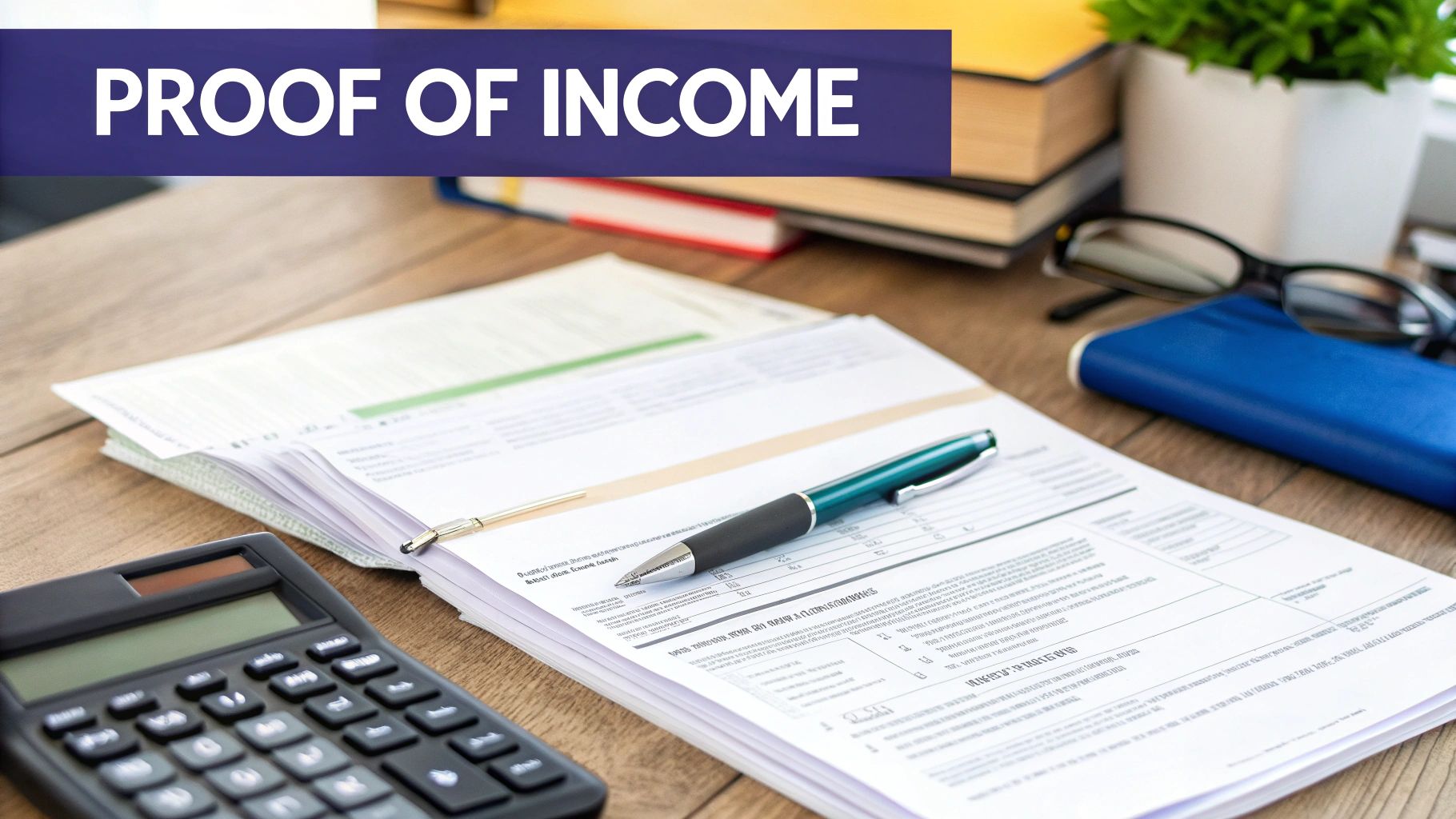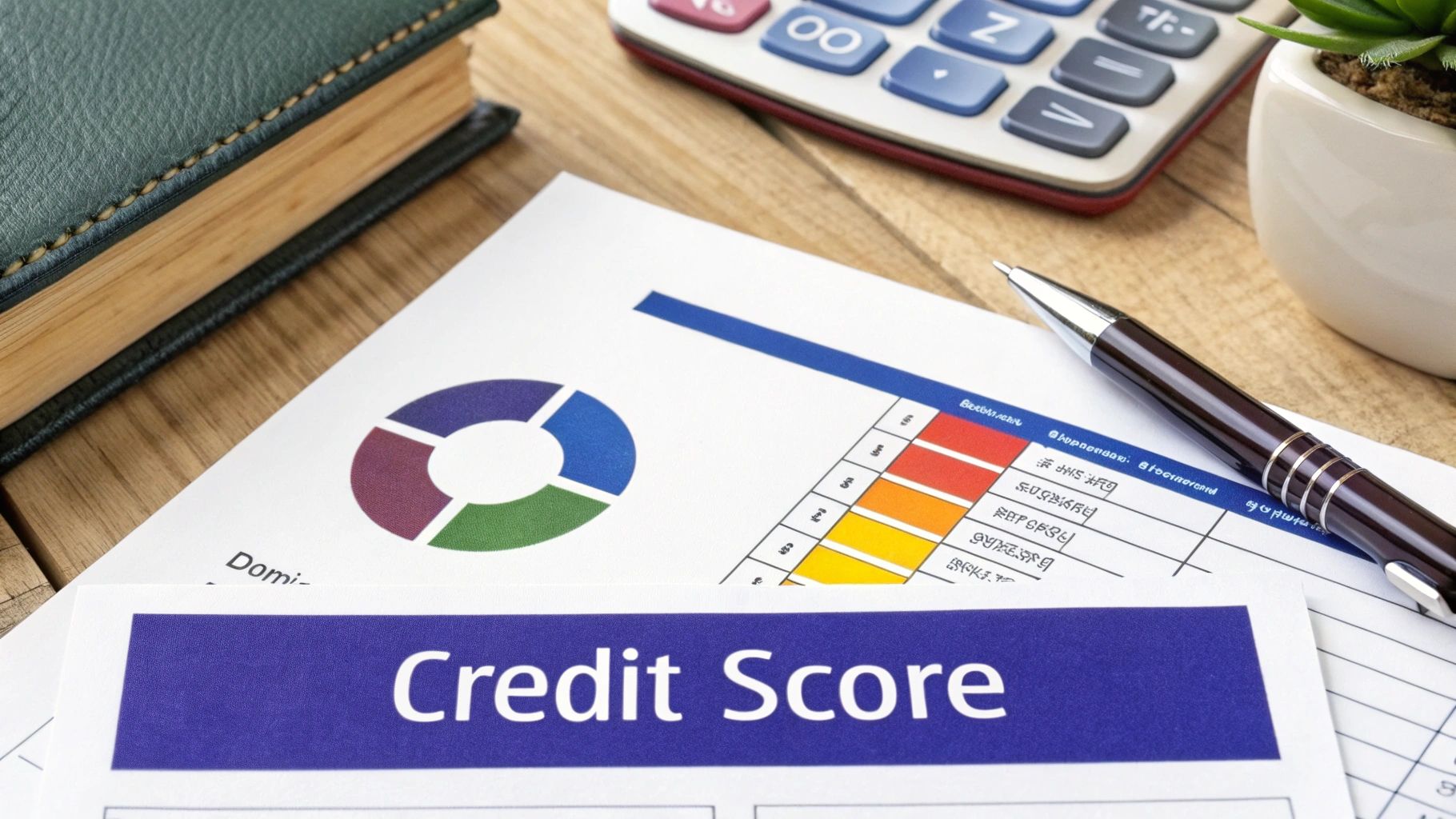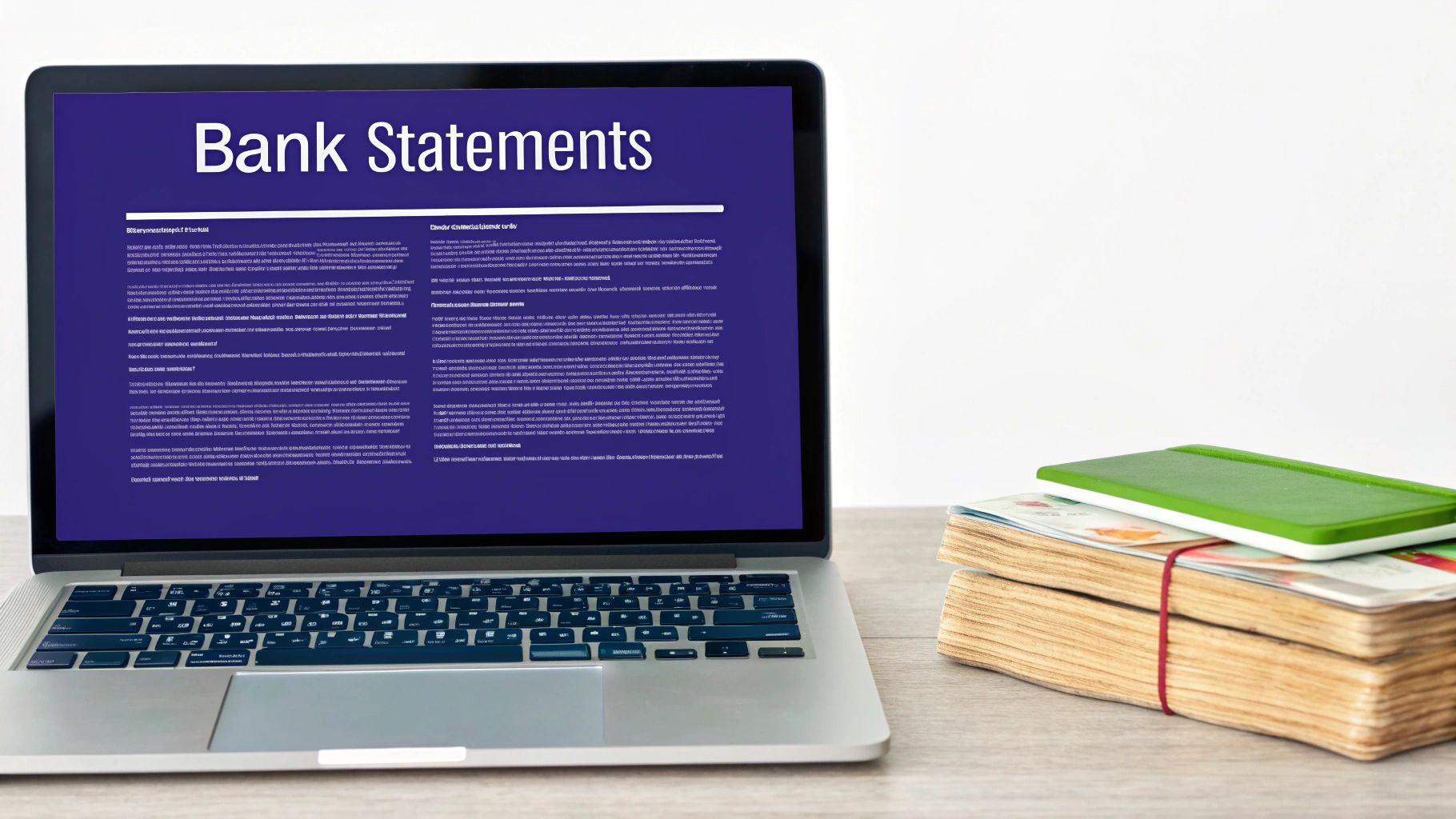Mortgage Document Checklist for 2025: Essential Tips
- WebsiteFix Technical Partner
- Jul 2
- 14 min read
Securing a mortgage can feel like navigating a complex maze of paperwork, but it doesn't have to be a source of stress. Lenders need a complete picture of your financial health to approve your home loan, and a well-organized file is your most powerful tool for a smooth process. Think of it less as a hurdle and more as a strategic game plan where preparation is key. This guide is designed to be your definitive mortgage document checklist, transforming a potentially overwhelming task into a series of clear, manageable steps.
We will break down every essential document across eight core categories, from proving your income to verifying your assets and identity. For each item, you will learn not just what you need, but why lenders require it and how to present it effectively. This comprehensive roadmap eliminates guesswork, ensuring you're prepared for every request. By understanding the purpose behind the paperwork, you gain control over the narrative of your financial stability. With this detailed checklist in hand, you can confidently gather everything needed, anticipate lender questions, and move efficiently toward closing on your new home. Let's start building your complete application package.
1. Proof of Income Documentation
Your proof of income is the cornerstone of your mortgage application. Lenders meticulously review these documents to verify you have a stable and sufficient income stream to handle monthly mortgage payments. This part of the mortgage document checklist is often the most detailed, as it directly proves your ability to repay the loan.

The specific documents required depend entirely on how you earn a living. Lenders need to see a consistent history, so they typically ask for records spanning the last two years.
What You'll Need
Here’s a breakdown of common income verification documents:
For Salaried/W-2 Employees: * Pay Stubs: Your most recent pay stubs covering the last 30 days. * W-2 Forms: From the past two years, for all employers. * Tax Returns: Complete federal tax returns (all pages and schedules) for the past two years.
For Self-Employed Individuals or Freelancers: * Tax Returns: Two years of personal and business tax returns. * Profit and Loss (P&L) Statement: A year-to-date P&L statement. * 1099 Forms: From all clients for the past two years.
For Other Income Sources (Rental, Alimony, etc.): * Lease Agreements: For rental property income. * Social Security/Pension Award Letters: To verify retirement or disability income. * Court Orders: Documentation for alimony or child support.
Pro Tips for Success
A smooth income verification process can significantly speed up your loan approval. Before submitting, organize all documents chronologically. If you are self-employed, ensure your business and personal finances are clearly separated to avoid confusion.
Key Insight: Avoid making large, undocumented cash deposits into your bank accounts in the months leading up to your application. Lenders must source all funds, and unexplained deposits can raise red flags, potentially delaying or even jeopardizing your loan approval. Consistency is your best asset.
2. Credit History and Score Documentation
Your credit history serves as a financial resume, providing lenders with a detailed look at your borrowing habits and reliability. These documents, including credit reports and scores, are critical for lenders to assess risk, which directly influences your loan terms, interest rates, and the likelihood of approval. A strong credit profile is a key component of any successful mortgage document checklist.

Lenders will pull your credit report from all three major bureaus (Equifax, Experian, and TransUnion) and use the middle score for qualification purposes. They are looking for a consistent record of on-time payments and responsible credit management.
What You'll Need
Here is a breakdown of the credit-related documentation you may be asked to provide:
Credit Report Authorization: A signed form giving the lender permission to pull your full credit reports.
Letters of Explanation: For any negative items on your report, such as late payments, collections, or judgments. For example, you might need to provide a letter explaining that a collection account was the result of a past medical emergency.
Alternative Credit Documentation: If you have a limited credit history (a "thin file"), you may need to provide records of consistent payments for things like rent, utilities, or insurance premiums.
Proof of Paid Collections: Documentation showing that any collection accounts have been settled or paid in full.
Pro Tips for Success
A clean credit report is one of your most powerful negotiating tools. Review your credit reports from all three bureaus at least 3-6 months before applying for a mortgage. This gives you ample time to dispute any errors, which can be a lengthy process. Also, focus on paying down existing credit card balances to improve your credit utilization ratio.
Key Insight: Resist the temptation to open any new credit accounts or make large purchases on credit during the mortgage application process. A new inquiry or a sudden increase in your debt-to-income ratio can lower your credit score and force the lender to re-evaluate your entire application, potentially leading to a denial even after pre-approval.
3. Asset and Bank Statements
Beyond proving your income, lenders need to see that you have the funds for a down payment and closing costs, as well as cash reserves for future payments. Your asset and bank statements provide a clear picture of your financial health and stability. This part of the mortgage document checklist is crucial for verifying you have the required capital to close the deal and manage homeownership.

Lenders will typically request statements from the last two to three months for all your accounts. They are looking for the source of your funds and a pattern of financial responsibility. Every page of your statements, even the blank ones, will be required to ensure a complete record.
What You'll Need
Here is a list of the typical asset documents you will need to gather for your application:
Bank Statements: For all checking and savings accounts. Be prepared to provide every page for the last 60-90 days.
Investment Account Statements: This includes brokerage accounts, stocks, bonds, and mutual funds.
Retirement Account Statements: The most recent statements for your 401(k), IRA, or other retirement funds.
Gift Letter: If a portion of your down payment is a gift, you will need a signed letter from the donor stating the funds are a gift and not a loan.
Proof of Sale: For a move-up buyer, documentation showing the proceeds from your previous home sale.
Pro Tips for Success
Keep your asset documentation clean and easy for the underwriter to follow. Before applying, gather all statements in digital format (PDFs) and label them clearly. If you are receiving down payment assistance, ensure you have all the specific program documentation ready.
Key Insight: Avoid moving large sums of money between your accounts right before or during the mortgage process. Each transfer creates a paper trail that you will have to explain. If a large, non-payroll deposit appears, source it immediately with a clear explanation and supporting documents to prevent underwriting delays.
4. Employment Verification Letters
While your pay stubs and W-2s show your past income, lenders need to confirm your current employment status and future stability. An employment verification letter serves as a direct, official confirmation from your employer about your job. This piece of the mortgage document checklist is critical because it assures the lender that your primary source of income is secure right before they fund your loan.

Lenders typically request this letter close to your closing date to get the most up-to-date information. They need to verify that you haven't changed jobs or had a negative change in your compensation during the underwriting process.
What You'll Need
Your lender will usually contact your employer's Human Resources department directly, but you may need to facilitate the process. The letter must be on official company letterhead and include:
For Corporate or Salaried Employees: * Position and Title: Your official job title. * Employment Dates: Your start date and confirmation of current employment. * Salary/Wages: Your current salary, hourly rate, and any guaranteed bonuses or commissions. * Likelihood of Continued Employment: A statement from the employer confirming your employment is expected to continue.
For Government Workers: * An official employment certification that follows government agency protocols, often with similar information as a standard corporate letter.
For Contract Workers: * Letters from major clients or copies of current, signed contracts that specify the duration and payment terms.
Pro Tips for Success
A delayed verification letter can postpone your closing. Give your HR department or manager a heads-up that a request will be coming from your lender. It's also wise to provide your lender with the direct contact information for the person who can complete the verification to avoid unnecessary back-and-forth.
Key Insight: Do not change jobs, get demoted, or switch from salaried to commission-based pay during the mortgage process without first consulting your loan officer. Any change to your employment can trigger a re-evaluation of your entire application, potentially leading to delays or even a loan denial. Stability is paramount.
5. Property Documentation and Appraisal
Once you've found a home, the focus shifts to the property itself. Lenders require extensive documentation to confirm the property's value and legal standing, ensuring it serves as adequate collateral for the loan. This part of the mortgage document checklist is crucial because it directly links the loan amount to a tangible, valuable asset.
The lender will commission a third-party appraisal to get an unbiased professional opinion of the home's market value. The property must appraise for at least the sales price for the loan to move forward. This process protects both you and the lender from overpaying for a property.
What You'll Need
Here’s a breakdown of the property-related documents you and your real estate agent will gather:
Purchase Agreement: The fully executed contract signed by both you and the seller, detailing the sales price and terms.
Property Appraisal Report: Ordered by the lender but paid for by you, this report determines the home's official value.
Property Disclosures: Forms from the seller outlining any known issues with the property, such as past floods or structural problems.
Title Search and Insurance Policy: A report confirming the seller's legal right to sell the property and a policy to protect you and the lender from future claims against the title.
Condo/HOA Documents: If applicable, you'll need the association's master policy, budget, and bylaws.
Pro Tips for Success
A proactive approach to property documentation can prevent significant closing delays. Order the appraisal immediately after your contract is signed, as it can take several weeks to complete. Review all seller disclosures carefully with your agent to understand exactly what you are buying. Any issues found in the title search must be addressed right away to avoid jeopardizing the closing date. Ensuring document integrity in real estate transactions is paramount.
Key Insight: The appraisal value is non-negotiable from the lender's perspective. If the appraisal comes in low, you have three primary options: the seller can lower the price, you can pay the difference in cash, or you can walk away from the deal if you have an appraisal contingency. Be prepared for this possibility.
6. Debt Documentation and Liabilities
Alongside your assets, lenders need a complete picture of your financial obligations. Providing thorough debt documentation and a list of your liabilities is a critical part of the mortgage document checklist. This information allows lenders to calculate your debt-to-income (DTI) ratio, a key metric that determines how much you can comfortably afford to borrow.

Your DTI ratio compares your total monthly debt payments to your gross monthly income. A lower DTI ratio signals to lenders that you have a healthy balance between debt and income, making you a less risky borrower. Accuracy and completeness here are non-negotiable.
What You'll Need
Gather statements for every single debt you hold. Lenders will cross-reference this information with your credit report, so ensure nothing is omitted.
Credit Cards: Most recent statements for all credit card accounts, showing the current balance and minimum monthly payment.
Auto Loans: Statements for any car loans, detailing the lender, outstanding balance, and monthly payment amount.
Student Loans: Recent statements from all student loan servicers. For income-driven repayment plans, provide documentation of the exact monthly payment, even if it's $0.
Other Loans: Include documentation for any personal loans, installment loans, or other lines of credit.
Obligations: Provide copies of court orders for any required alimony or child support payments.
Pro Tips for Success
Managing your liabilities proactively before you apply can significantly improve your loan candidacy. A low DTI ratio is one of the most powerful factors in your favor.
Key Insight: Do not open new lines of credit or make major purchases on existing credit cards after you start the mortgage process. Any new debt can alter your DTI ratio and force the lender to re-evaluate your entire application, potentially leading to a last-minute denial. Stability is crucial until the loan is closed.
7. Legal Identity and Residency Documentation
Your legal identity and residency documents are crucial for verifying who you are and where you live. Lenders use this information to comply with federal regulations like the Patriot Act, which helps prevent fraud and money laundering. This step on the mortgage document checklist confirms your eligibility for certain loan programs and ensures all legal paperwork is accurate.
These documents must be valid, unexpired, and clearly legible. Consistency across all documents is key, as any discrepancies in names or addresses can cause significant delays in the mortgage approval process.
What You'll Need
Here is a breakdown of the specific documents required to prove your identity and residency:
Proof of Identity: * Driver’s License or State ID Card: A clear copy of the front and back. * U.S. Passport: Can be used as a primary form of identification. * Social Security Card: A copy to verify your Social Security Number.
Proof of Residency/Citizenship Status: * Permanent Resident Card (Green Card): For non-U.S. citizens who are permanent residents. * Employment Authorization Document (EAD): If applicable. * Certificate of Naturalization: To prove U.S. citizenship if you were not born in the U.S.
Additional Documentation (if applicable): * Marriage Certificate: If you have recently married and your name has changed. * Divorce Decree: To document a legal name change or separation of assets. * Military ID: For service members, especially those using a VA loan.
Pro Tips for Success
Ensuring your legal documents are in perfect order can prevent frustrating setbacks. Before you apply, double-check that your full legal name is spelled identically on all forms of identification. Many legal documents now require notarization, and understanding how remote online notary services can help can streamline this part of the process.
Key Insight: If you've recently moved or your ID has an old address, be prepared to provide additional proof of residency, like recent utility bills or a signed lease agreement. Lenders must verify your current physical address, and a mismatched ID can be a major red flag.
8. Loan Application and Disclosure Documents
The formal loan application and accompanying disclosures are the legal backbone of your mortgage transaction. These documents, standardized in part by the Consumer Financial Protection Bureau (CFPB) after the 2008 financial crisis, provide a transparent overview of your loan terms, estimated costs, and rights as a borrower. This section of your mortgage document checklist ensures you understand and agree to the legal framework of your home loan.
This paperwork officially begins your application process. After you submit, you will receive a series of disclosures that are critical to review. These forms are designed to protect you by making the lending process clear and predictable, allowing you to make an informed decision.
What You'll Need
Here’s a breakdown of the key documents you will fill out and receive:
Uniform Residential Loan Application (Form 1003): This is the standard application form used by nearly all lenders. It details your personal information, employment, income, assets, and liabilities.
Loan Estimate (LE): You must receive this within three business days of applying. It provides a detailed breakdown of the estimated interest rate, monthly payment, and total closing costs.
Closing Disclosure (CD): This five-page form arrives at least three business days before your closing date. It finalizes all costs and must be compared against the Loan Estimate to check for discrepancies.
Pro Tips for Success
Thoroughly reviewing these documents is non-negotiable. Don’t hesitate to ask your loan officer to clarify any terms, fees, or conditions that are unclear. Many of these forms require your signature, and in some cases, a notary may be required to witness it. Understanding the process can be simplified by exploring your options, such as using an online notary service which can be a convenient solution. For more details on this, you can learn more about getting documents notarized online.
Key Insight: The three-day review period for the Closing Disclosure is a mandatory consumer protection. Use this time wisely. Compare every line item on the CD with your initial Loan Estimate. If there are significant, unexplained changes in fees or terms, you have the right to question them and demand an explanation before you sign.
Mortgage Document Checklist Comparison
Documentation Type | Implementation Complexity 🔄 | Resource Requirements ⚡ | Expected Outcomes 📊 | Ideal Use Cases 💡 | Key Advantages ⭐ |
|---|---|---|---|---|---|
Proof of Income Documentation | Medium to High - complex for self-employed | Moderate - multiple documents over 2-3 years | Strong loan repayment verification; lender confidence | Salaried employees, freelancers, investors | Demonstrates financial stability; better loan terms |
Credit History and Score Documentation | Medium - requires gathering reports and explanations | Low to Moderate - credit reports and explanations | Accurate risk assessment; better loan terms and approval chances | All borrowers, especially those with credit issues | Addresses credit issues; unlocks better rates |
Asset and Bank Statements | Medium - involves multiple accounts and verifications | Moderate - several months of statements required | Demonstrates savings and reserves; supports down payment capability | Buyers needing to prove cash reserves or gifts | Shows financial discipline; strengthens applications |
Employment Verification Letters | Low to Medium - coordination with employer | Low - official letters needed near closing | Verifies job stability; confirms income | Borrowers with stable employment or contracts | Provides third-party income verification |
Property Documentation and Appraisal | Medium - multiple documents and third-party dependencies | Moderate to High - appraisals, surveys, inspections | Confirms collateral value; identifies issues | All property purchases or refinances | Ensures property value supports loan; legal protection |
Debt Documentation and Liabilities | Medium - requires comprehensive debt records | Moderate - collection of statements and agreements | Accurate debt-to-income calculation; borrowing capacity evaluation | Borrowers with multiple debts or obligations | Complete financial picture; optimizes debt management |
Legal Identity and Residency Documentation | Low - official ID and proof of residency needed | Low - government issued IDs and proofs | Regulatory compliance; fraud prevention | All borrowers; especially non-citizens or immigrants | Meets legal requirements; prevents fraud |
Loan Application and Disclosure Documents | Medium - formal application plus multiple disclosures | Moderate - numerous legal documents required | Legal protections; transparent loan terms | All borrowers in mortgage transaction | Standardizes loan info; ensures informed decisions |
From Checklist to Closing Day: Your Next Steps
Congratulations, you have officially navigated the comprehensive mortgage document checklist. Moving from proof of income to loan disclosures, you now possess a clear roadmap. This isn't just about collecting papers; it’s about strategically building a compelling financial narrative that lenders can confidently support. By proactively organizing your documents, you transform a potentially overwhelming process into a manageable, step-by-step project.
The ultimate goal of this preparation is to minimize friction and maximize your opportunities. A complete and well-organized file prevents last-minute scrambles for a missing pay stub or an old W-2, which are common sources of closing delays. Remember, your lender is looking for consistency and reliability. Every document you provide contributes to a bigger picture of you as a trustworthy borrower. This organized approach is your most powerful tool for securing favorable loan terms and a smoother path to homeownership.
Your Action Plan for Success
With the knowledge from this mortgage document checklist in hand, it's time to take action. Don't wait for your lender to send you a request list. Get ahead of the game with these concrete next steps:
Create a Digital Vault: Start today by creating a secure, encrypted folder on your computer or cloud storage. Label subfolders for each of the eight categories we discussed: Income, Assets, Debt, Employment, etc. As you gather each document, scan it and save it with a clear, descriptive name (e.g., "Pay-Stub-March-2024.pdf").
Review and Reconcile: Go through your credit report with a fine-tooth comb. Does it match the liabilities you’ve listed? Are there any errors or unfamiliar accounts? Addressing these discrepancies now, before you formally apply, can prevent significant headaches and potential loan denials later.
Identify Notarization Needs: Look ahead to the closing process. Documents like the Deed of Trust, Mortgage Note, and various affidavits will require official notarization. Understanding this requirement early allows you to plan for a seamless and secure signing experience, avoiding any last-minute logistical issues that could jeopardize your closing date.
Key Insight: Mastering your mortgage document checklist is more than an administrative task. It is the foundational act of taking control of your home-buying journey, empowering you to negotiate from a position of strength and preparedness.
Ultimately, your diligence now pays immense dividends later. A meticulously prepared application package signals to lenders that you are a serious, organized, and low-risk applicant. This preparation directly translates into a faster underwriting process, fewer follow-up questions from your loan officer, and a greater sense of confidence as you move toward the closing table. You’ve done the hard work of building your financial life; now is the time to present it with the clarity and professionalism it deserves.
Ready to ensure your closing documents are handled with flawless precision and convenience? From loan signing packages to affidavits, Signature on Demand offers expert mobile and remote online notarization services to finalize your mortgage journey securely and efficiently. Visit Signature on Demand to schedule a professional notary who comes to you, on your time.







Comments